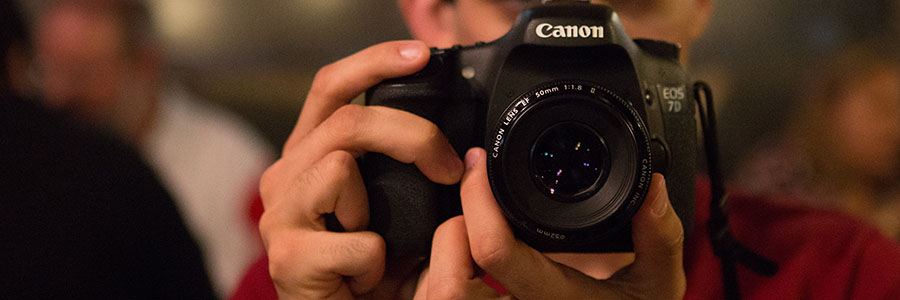When I bought my first camera, I had no clue what I was looking for as far as cameras went. I knew my budget and pressed “checkout”. But now as a photographer, I get this question ALL the time: “What kind of camera should I get?” Buying a camera is no easy task and is quite an investment. There are literally hundreds, maybe thousands, of ways to answer that question. While I don’t mind helping my friends pick out a camera for themselves, I decided that writing this guide would be a great way to get the ball rolling for a future camera owner. :]

Elysia doing portraits of Sam
1. Figure out what you’re going to do with your camera
Many times a friend goes out and buys a DSLR because they love the quality of the images that come from it only to constantly leave it at home because the camera itself is too bulky to carry around. Take some time before you go out to buy a camera to figure out what you need a camera for! Are you going to want to keep a DSLR on you whenever you want to take a photo? Are you looking to expand your skill in photography? Do you just want something to carry around every day? Does it have to be light and portable? Where are you going to put it when you go out? Point and shoots and compacts are light, portable and easy to use, but lack some photo quality. DSLRs provide superior photo quality at the cost of portability. Mirrorless and micro 4/3rds give you something in between the two, but usually are pricier. Give it some thought.

2. Work Out Your Budget
Once you figured out what style of camera you want, you have to set yourself a budget. Cameras can range from a couple hundred bucks to a couple thousand dollar investment. Point and shoots and compacts can run anywhere from $100 to $700. Mirrorless, micro 4/3rds, and DSLRS can run $400+, not including lenses if it doesn’t come with one. Then there’s all the accessories.

Davin is a cosplay photographer who uses his camera for stills. Minh uses his camera for video
3. Find Out What Features You Want
Now a days, it’s no longer just about megapixels. Cameras are no longer the one trick ponies they were back in the analog era. Most still cameras come with video capabilities, external mic ports, hot shoe mounts, usb ports, wireless, etc. Do you need all these? Maybe not, but make sure the camera you buy comes with the ones you want. Does it shoot in 4K, 1080p, or 720p? Does it shoot at 60 frames a second? Does it have an on-board flash? (Some DSLRs have no on-board flash). Can it shoot 15 photos in a couple seconds? Does it do well shooting at night? Check your specs! Or go to a website that sorts all those details for you.

4. Feel of the Camera
More often than not, the difference between camera brands as far as specs are minuscule. What it really comes down to is if you’re comfortable handling the camera. Hold it in your hand. Flip through the menus. Press the buttons. Does it feel right? Is it easy to use and manipulate? When I bought my first DSLR the deciding factor between a Canon and Nikon was simply that I was familiar with Canon’s user interface. The Canon XSi was light and small in my hands compared to a 7D, but the 7D fit my hand better and felt like it could take a beating. Go to your local electronics store and pick up the cameras and play with them a bit.
Hope this points you in the right direction! Don’t get too hung up on gear though! As Chase Jarvis once said: “The best camera is the one that’s with you.”
Do you have any tips to choosing a camera? Leave it in the comments below!
Get a camera, get out there, and take some photos!
Thanks for reading!



